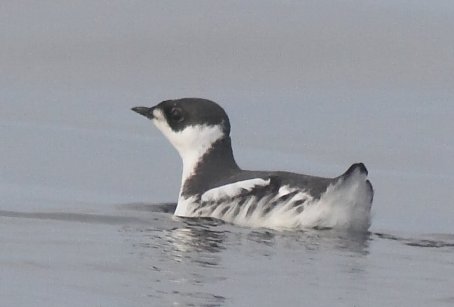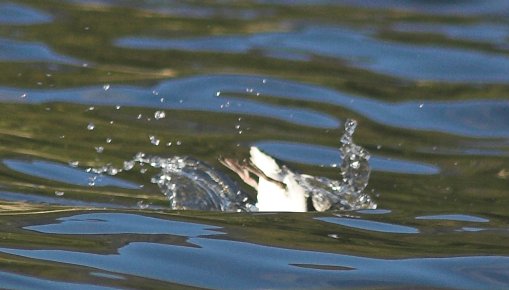
My first memories of Marbled Murrelets (Brachyramphus marmoratus) come from a time long before I even knew their name. I grew up in Sitka and it’s only natural to get out on the water when you live in a town like this. Over the course of my youth, I went on many outings with family and friends that including hunting and fishing trips, as well as picnics and other excuses to get out of town. Through these boat trips, I came to expect small brown birds that almost always dove down rather than taking off as the boat approached. It seems strange to me now, that I never was more curious about them then. I suppose I may have asked my dad what they were, but I do not recall what answer he would have given me, if any. Now that I am back in Sitka as an adult with a keen interest in learning about the natural world, the Marbled Murrelets have special place in my understanding, as they are one of a few species of plant or animal that I have clear recollections of from my youth.
My (re)introduction to Marbled Murrelets really came this past summer as I worked with Allen Marine Tours as a naturalist. It did not take me long to figure out what they were and put together some basic facts about them. Somewhere along the way, probably due to their status as an at risk species in the lower-48 states, I learned that they nest in Old-growth Forests. I knew they are in the Alcid family, and related to other sea birds like the puffins, murres, and auklets. This summer I also learned that they can nest up to 30 miles inland. Beyond that, and the brief anecdotes from my youth, I still did not know much about these birds.
Last Thursday, I had the opportunity to listen to a talk about Marbled Murrelets given by Matt Kirchhoff, a biologist with the Alaska Department of Fish and Game, who has been studying Marbled Murrelets in Southeast Alaska in recent years. Through his presentation, I learned that this mystery bird of my youth has presented something of a mystery to Western Science since it was first described over 200 years ago. Much of what follows below is my retelling of some of the things that stuck with me after listening to the presentation.
The Alcid family is a group birds that feed by diving for food in the ocean. In adapting to this niche, their ability to fly through the air has been sacrificed somewhat, in order to better swim through the water. Birds in this family actually use their wings to ‘fly’ through the water rather than their feet for propulsion. This is why when you see a Marbled Murrelet dive, it just tips forward with its feet up in the air and is still able to dive below the surface.

Diving Marbled Murrelet
Despite their abundance on the waters of Southeast Alaska (where their population is estimated to be well over 600,000 birds), little was known about their natural history until recently. It was not known where these birds even nested until the first nest was discovered way back in 1974, almost 200 years after the bird was first described by science. The nest was discovered by a tree climber in California over 140 feet above the ground. Since that time it has been determined that the Marbled Murrelets in California, Oregon, and Washington have a strong dependence on Old-growth Forest, a habitat type that has been drastically reduced by modern logging and other development. The species was listed as Threatened under the Endangered Species Act in the lower-48 states, and it has been the subject of much study. Over the last couple of decades, these studies have resulted in a much better understanding of Marbled Murrelets, though significant mysteries remain.
As members of the Alcid family, Marbled Murrelets are adapted for ‘flying’ underwater. This adaptation has come at the expense of easy flight through the air. As a practical matter, these birds are unable to fly slow and maintain loft. They must fly fast, generally at least 40 miles per hour (though they have been clocked at over 100 miles per hour coming down from the forest). As a result, they are unable to take off from the ground and you may often see them bouncing off waves as they try to take off and remain airborne. (I guess this might be why they always seemed to dive rather than take off when I saw them while boating in my younger years.)
Unlike any other Alcid, Marbled Murrelets nest in trees. This goes some way to explaining why their summer plumage is so much more drab than their black and white winter plumage; it’s necessary to avoid detection by predators. If you can, try to imagine what it might be like to try landing on a small nest hollowed out in a clump of moss growing on a narrow tree branch when you are incapble of slow flight and tight turns. It turns out that they approach the nest by flying in through an opening in the canopy (one of the characteristics of old-growth is a broken canopy) come in well below the level of the nest, then fly up to the nest, stalling out at just the right elevation to end up at the nest. The way out just reverses the way in with a fall from the nest to gain the necessary speed for actual flight out of the woods. Oh, and did I mention that they do this in the dark when they are nesting and caring for young?

Calling Murrelet
The parents seem to pair up and stay together for multiple years. Even in the winter you will usually seem them paired off. When they are diving to feed and one comes up without the other, they will call out until they find each other. During the summer they take turns incubating their single egg, doing 24 hour shifts. They both take turns feeding the young bird, making multiple flights a night carrying fish hanging out of its beak. (Remember how hard it is to fly even without the extra drag? Remember that they can nest up to 30 miles inland? Remember the approach they must make to land on their nest? Are you amazed at this bird yet?)
Now lets imagine the first flight of the young bird. Your entire life to this point has been spent far up a tree in a small nest hollowed out of a clump of moss on the branch of a tree. You have approximately as long as it takes to fall to the ground from whatever height your nest is at to figure out how to fly. Not only that, but you better be an expert right away, because you only get one shot to make it to water. If your flight stalls out and you end up on the ground, you are not going to be able to take off again. It’s almost like if you took a child who had never been out of a crib and insisted that not only did he need to figure out how to walk in the next 2 seconds, but he had better get a move on, because he also needed to complete a 5k race if he ever wanted to eat again. I guess it’s not really a big surprise that the reproductive success of these birds is relatively low in any given year.
Another interesting thing that has only recently been discovered about these birds is that they seem to fly inland year round. There are not as many that fly in during non-nesting months, but with the exception of the fall months when the molt occurs and the birds are unable to fly, Marbled Murrelets have been observed flying inland and back out again around the time of dawn throughout the year. It is unclear why they might do this.
Next summer there will be some research done around Sitka to learn a little more about the behavior of Marbled Murrelets in this area (much of the research in Southeast to this point has been done in more inside waters). It will be interesting to see is learned about these fascinating birds.
1 thought on “Marbled Murrelets”